You are using an out of date browser. It may not display this or other websites correctly.
You should upgrade or use an alternative browser.
You should upgrade or use an alternative browser.
Empires of Liberty
- Thread starter JJohnson
- Start date
As long as you're cured of your islamophobia the thing have been nice so far, very nice with the details
And rememeber, our own flame wars was that, you still bellitle and have that hate against Islam and Muslims?
I would be glad to hear this as well.
JJohnson
Banned
Presidents
After President Washington, we had...
1796-1800: John Adams (MA); VP: Thomas Jefferson
1800-1808: Thomas Jefferson (VA); VP: George du Calvet, George Clinton
1808-1816: James Madison (VA); VP: George Clinton, Stephen Bamford
1816-1824: James Monroe (VA); VP: William David Henry
1824-1828: John Quincy Adams (MA); VP: Thomas Eddy
1828-1836: George Holmes (NS); VP: John C Calhoun, Martin Van Buren
After President Washington, we had...
1796-1800: John Adams (MA); VP: Thomas Jefferson
1800-1808: Thomas Jefferson (VA); VP: George du Calvet, George Clinton
1808-1816: James Madison (VA); VP: George Clinton, Stephen Bamford
1816-1824: James Monroe (VA); VP: William David Henry
1824-1828: John Quincy Adams (MA); VP: Thomas Eddy
1828-1836: George Holmes (NS); VP: John C Calhoun, Martin Van Buren
Presidents of the United States, © 2001
Second President: John Adams
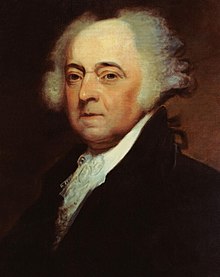
Term: March 4, 1797 – March 4, 1801
Party: Federalist
Vice-President: Thomas Jefferson (Dem-Rep)
John Adams served during the short French-American War, which ended in 1799, with the end of empressment of French-speaking Americans, and transferred the islands of St. Pierre et Miquelon to the state of Quebec. Even with this, the Alien and Sedition Acts soured much of the country on his re-election, leading to the third President, Thomas Jefferson.
As Vice-President, Jefferson reformed Senate Rules, and was an active participant in Senate proceedings, attending nearly every meeting of the Senate as time permitted.
Presidents of the United States, © 2001
Third President: Thomas Jefferson
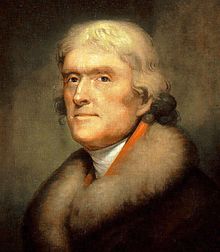
Term: March 4, 1801 – March 4, 1809
Party: Democratic-Republican
Vice-President: George du Calvet, George Clinton
Thomas Jefferson's election represented the first peaceful transfer of power between opposite political parties, something most Americans today take for granted. His presidency featured a number of momentous acts, starting with the Louisiana Purchase in 1803 from France. His wife, Martha, helped choose the surveyors of the land, Lewis and Clark, and urged the famous cartographer from Nova Scotia, Edward William Holmes, to draw a new official map of the United States for the White House based on their findings. The resulting painting still hangs in the Jefferson Room of the White House to this day.
A slave, Betty Hemmings, came with Martha after the death of her last child, Sally, a stillborn, in 1773, and aided Martha through her own childbirths, resulting in seven children: Martha "Patsy" Washington Jefferson (1772), Jane Randolph Jefferson (1774), Peter Jefferson (1777), Mary "Polly" Jefferson (1778), Lucy Elizabeth Jefferson(1780), Abigail Elizabeth Jefferson (1782), Thomas Randolph Jefferson (1783).
His first Vice President, George du Calvet, was not renominated so that he could accept the governorship of Quebec.
Presidents of the United States, © 2001
Fourth President: James Madison
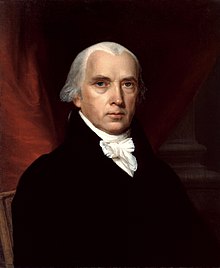
Term: March 4, 1809 – March 4, 1817
Party: Democratic-Republican
Vice-President: George Clinton, Stephen Bamford
Madison's first term was marked both by increasing prosperity and economic growth, as well as deterioration in international relations with the United Kingdom. His second term was dominated by the War of 1812, commonly called the British-American War in the first half of the 19th century, and the Second War of Independence in the second.
The war had a number of memorable events, including the burning of Quebec City and Washington DC, the defense of Ft. McHenry, inspiring the "Star-Spangled Banner," and the Battle of New Orleans, famously fought after the peace treaty was drafted. Its hero, Major General Andrew Jackson, served later in the Seminole Wars, as military governor of Florida, and died in the second Seminole War in 1822.
Presidents of the United States, © 2001
Fifth President: James Monroe

Term: March 4, 1817 – March 4, 1825
Party: Democratic-Republican
Vice-President: William David Henry
President Monroe oversaw the purchase of Florida from Spain with the Adams-Onis Treaty, and by 1822 reported to Congress that, after the Napoleonic Wars, most of Spain's colonies had revolted and established stable governments in the United States of Colombia, Mexico, and Peru. His Secretary of State, John Quincy Adams, under his direction, send instructions for ambassadors to those countries, encouraging republican institutions and free elections and trade for all the Americas.
They declared that the policy of the United States was to uphold republican institutions and to seek treaties of commerce on a most-favored-nation basis. The United States would support inter-American congresses dedicated to the development of economic and political institutions fundamentally differing from those prevailing in Europe. The articulation of an "American system" distinct from that of Europe was a basic tenet of Monroe's policy toward Latin America. Monroe took pride as the United States was the first nation to extend recognition and to set an example to the rest of the world for its support of the "cause of liberty and humanity."
In a speech to Congress, which was actually written by Adams, who designed the doctrine in cooperation with Britain, and later called the "Monroe Doctrine," he proclaimed that the Americas should be free from future European colonization and free from European interference in sovereign countries' affairs. It further stated the United States' intention to stay neutral in European wars and wars between European powers and their colonies, but to consider new colonies or interference with independent countries in the Americas as hostile acts toward the United States.
The Monroe Doctrine at the time of its adoption thus pertained more to the Russians in North America than to the former Spanish colonies. The result was a system of American isolationism under the sponsorship of the British navy. British colonies (British Honduras, Cuba, Jamaica, Bay Islands, Providence Islands, British Guiana, British Southern America, amongst others) were protected by the British Navy, with the Caribbean forming what was commonly called in London 'the British Lake.' This led the Americans to begin focusing their expansion north and west and into the Pacific.
JJohnson
Banned
More Presidents...
Presidents of the United States, © 2001
Sixth President: John Quincy Adams
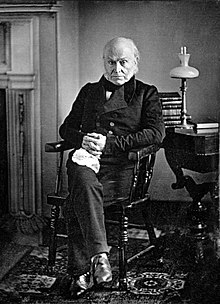
Term: March 4, 1825 – March 4, 1829
Party: Democratic-Republican
Vice-President: Thomas Eddy (Dem-Rep)
Before serving as President, Adams was a recognized diplomat, having negotiated the Treaty of Ghent, ending the British-American War, as well as the Treaty of 1818, setting the 49° parallel as the northern border between Louisiana Territory and Rupert's Land.
While President, Adams sought the construction of a Planetarium in the western hills of the federal district, in the western corner of the district, in what would become called the United States National Observatory and Planetarium, leading West Arlington, DC to become a thriving part of the modern federal district for scientific and technological research.
He reduced the national debt from $16 million to $5 million, the remainder of which would be paid off by his successor, George Andrew Holmes. Adams' more generous and friendly policies to the Indians antagonized settlers who wanted to expand west, while his support of the Tariff angered the southern Democrats.
In diplomacy, he signed a number of reciprocity agreements, with Denmark, Mexico, the Hanseatic League, the Scandinavian countries, Prussia, and Austria. He supported the Greek War of Independence, as they were viewed as the source of Western Civilization itself, but did not lend any active military support.
His son George served in the Texas War of Independence in 1836, and his son John served as an ambassador and later Secretary of State while his father served in the House of Representatives.
Presidents of the United States, © 2001
Seventh President: George Andrew Holmes
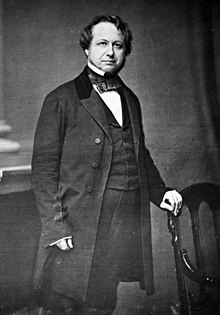
Term: March 4, 1829 – March 4, 1837
Party: Democratic-Republican
Vice-President: John C Calhoun, Martin Van Buren
Holmes was the first President from Nova Scotia, who moved as a teenager to the American frontier, in Tennessee, where he served as a state Senator to the US Congress until his election in 1828. He owned few slaves, and as a frontiersman lived in a wood cabin he built for several years. He was a very plain man and hated aristocracy, even among the political class, seeing it as Americans trying to be European, instead of proper republicans - a term he applied to himself as he viewed the republican model of the US as superior to even the parliamentary model.
His presidency saw the expansion into the west of large numbers of Americans, putting pressure on the Native Americans already living there. He passed the Indian Resettlement Act, which provided that if Indians formed a recognized settlement with elected representatives amongst themselves with written laws, then they could remain in the states. If they refused, they could sell their land to white settlers and move to the Indian Territory out west of Arkansas. A brief skirmish with the Cherokee Nation in Georgia led to the settlement of roughly half the tribe in the northwestern area of Georgia, while the other half was forcibly removed under Van Buren after a lengthy court trial over whether that part of the tribe duly owned the land that was sold to the Georgian settlers. Most Indians eventually sold their lands, and practically none were forcibly removed. To this day, a large number of Native Americans still live in their ancestral lands, but are in the minority due to the influx of white settlers over the years, and their settlements became the major cities of the eastern states.
His term saw the payment in full of the federal debt, the first of two times this has happened in US history, and the end of the National Bank, partly due to his mistrust of bankers and his belief it was unconstitutional. He recommended an amendment that the US debts must be repaid within 20 years of their being incurred, which has yet to be ratified. His other drive was pressing for Americans to spread across the continent, being one of hte main drivers of "Manifest Destiny," a term he actually used in a speech, to describe the special virtues of the American system of republicanism as opposed to democracy, the divine destiny of Americans to spread across America and civilize the land, and a manifest destiny to bring republicanism across the continent and eliminate those who would try to turn the country into another Europe. Democrats in the South latched onto his idea so that they could spread slavery to new territory in the west, while Whigs opposed the idea for the same reasons. Holmes was a vigorously active President, and returned to Tennessee after his term of office was over.
Holmes married Jessica Stoltenberg, whose family came from the Swedish island of Ny Pommern ("New Pomerania," Fr: Guadeloupe), and was the first First Lady who spoke a language other than English (the third Vice President, du Calvet, spoke French, as did his wife). The two had five children together, three sons and two daughters. They also adopted two children, a Creek Indian child named Thomas Jefferson Holmes, and Anne, another Indian about whom little is known.
Share: